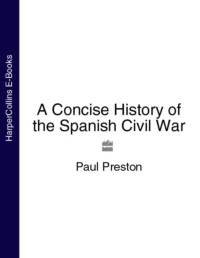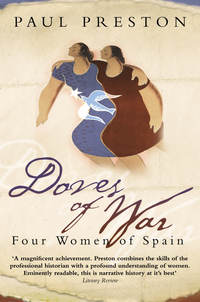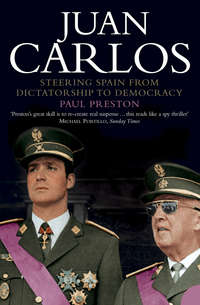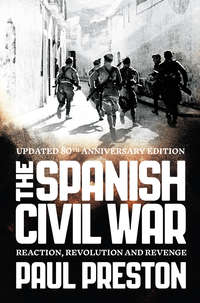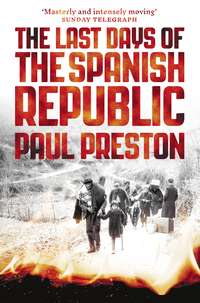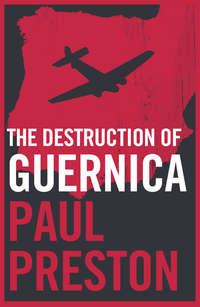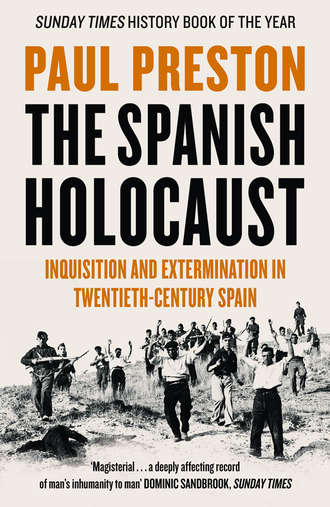
Полная версия
The Spanish Holocaust: Inquisition and Extermination in Twentieth-Century Spain
Demonstrating the Civil Guard’s support for employers determined to block Republican social legislation, the events at Castellar de Santiago were surpassed less than one month later. Now dominated by the extremist FAI, the anarchist movement launched an ill-prepared insurrection on 8 January 1933. It was suppressed easily in most of Spain, but in the small village of Casas Viejas (Cádiz) a savage repression ensued. With the best land around the village used for breeding fighting bulls, the inhabitants faced year-round unemployment, near-starvation and endemic tuberculosis. The writer Ramón Sender wrote of the poor being maddened with hunger like stray dogs. When the FAI declaration of libertarian communism reached the local workers’ centre, the villagers hesitantly obeyed. Assuming that all of Cádiz had followed the revolutionary call, they did not expect bloodshed and naively invited the local landowners and the Civil Guard to join the new collective enterprise. To their bewilderment, the Civil Guard replied to the offer with gunfire. Many fled the village, but some took refuge in the hut of the septuagenarian Curro Cruz, known as Seisdedos. Inside with Seisdedos were his two sons, his cousin, his daughter and son-in-law, his daughter-in-law and his two grandchildren. They and a few other villagers were armed only with shotguns loaded with pellets. A company of Assault Guards arrived under the command of Captain Manuel Rojas Feijespan. During a night-long siege, several were killed as machine-gun bullets penetrated the mud walls of the hovel. Rojas ordered the Guards to set fire to the hut. Those who tried to escape were shot down. Another twelve villagers were executed in cold blood.77
The immediate reaction of the rightist press was favourable, echoing its customary applause for the Civil Guard’s repression of the rural proletariat.78 However, when they realized that political capital could be made, rightist groups cried crocodile tears and echoed anarchist indignation. Before the full details of the massacre were known, all three Socialist ministers, especially the moderate Indalecio Prieto, had given Azaña their support for the anarchist rising to be suppressed.79 However, despite their hostility to the anarchists, the Socialists could not approve of the gratuitous brutality displayed by the forces of order. To make matters worse, the officers responsible claimed falsely that they had been acting under orders. They were backed up to devastating effect by the future leader of the Unión Militar Española. Captain Barba Hernández was on duty the night of 8 January 1933. When the scandal broke out, he defended his friend Captain Rojas Feijespan by claiming that Azaña had personally given the order ‘shoot them in the belly’. Seized upon by the right-wing press, the fabrication did immense damage to the Republican–Socialist coalition.80 Casas Viejas and its repercussions brought home to the Socialist leadership the cost of participation in the government. They saw that the defence of the bourgeois Republic against the anarchists was sacrificing their credibility with the Socialist masses.
There was further violence during the campaign for the re-run municipal elections on 23 April 1933. There were to be elections in twenty-one towns in the province of Badajoz, the most important being Hornachos. On that day, the Mayor of Zafra, José González Barrero, headed a demonstration in Hornachos of three hundred Socialists and Communists. Red flags were flown and revolutionary chants heard. Initially, on the orders of the Civil Governor, the Civil Guard stood back. However, local rightists, who were running in the elections as the Anti-Marxist Coalition, approached Rafael Salazar Alonso, one of the Radical deputies for the province, who was in Hornachos on that day. Since there was no telephone line to Hornachos, Salazar Alonso drove to the nearby town of Villafranca de los Barros where he telephoned the Minister of the Interior and called for the Civil Guard to be given the freedom to open fire. In his own account, he was still in Villafranca de los Barros when that happened. Other sources suggest that, in fact, he was present when, after stones were thrown and a shot fired, the Civil Guard in Hornachos began to shoot at the crowd. Four men and one woman were killed and fourteen people wounded. Forty workers were arrested, several of whom were badly beaten.81 It was widely believed that Salazar Alonso was responsible for the action of the Civil Guard in Hornachos on that day.82
The pugnacious and provocative Salazar Alonso was a man given to extreme enthusiasms who, prior to 1931, had been a fiery, anti-clerical Republican but had undergone a dramatic change after falling under the spell of the landed aristocracy of Badajoz. In consequence, he threw himself into the service of reactionary interests with the zeal of a convert and played an important role in the genesis of violence in southern Spain. According to Pedro Vallina, a celebrated doctor of anarchist beliefs, Salazar Alonso was ferociously ambitious and had adopted anti-clericalism as a way of rising to prominence within the Radical Party. He had been born and brought up in Madrid. In his father’s home town, Siruela in Badajoz, he had married the daughter of a wealthy landowner. He had made his early career manifesting radical views, but once he secured a seat in parliament he moved rapidly to the right. During his lightning visit to Villafranca de los Barros on 23 April 1933, he met Amparo, the wife of another even wealthier landowner, a man much older than herself. He abandoned his own wife and children and began an affair with Amparo, who began to visit him in Madrid. The austere and idealistic Dr Vallina was confirmed in his view that Salazar Alonso was ‘one of the most shameless and cynical men I have ever known’. Even the head of the Radical Party, the corrupt Alejandro Lerroux, commented wistfully that Salazar Alonso ‘frequented palaces where I had never been other than on official business’.83 Eventually, both because of and despite the adulterous nature of his relationship with Amparo, he would abandon Freemasonry and become a pious Catholic.84
Throughout the spring and summer of 1933, evidence mounted that the Republic’s social laws were simply being ignored. Official labour exchanges and the arbitration committees known as mixed juries were bypassed and work offered only to men who would tear up their union cards. Land was withdrawn from cultivation. There were ever more cases of landowners shooting at workers. A meeting of the national committee of the UGT was held in mid-June to consider the drift to anarchist and Communist organizations of members frustrated by Socialist efforts to maintain worker discipline in the face of provocation.85
Workers – especially in the countryside – were being forced into increasing militancy by the employers’ refusal to comply with social legislation. As long as the Socialists had a presence in the government and could offer the prospect of reform, the unions would still respond to calls for discipline and patience. However, for some time, Alcalá Zamora had been seeking an opportunity to get the Republican–Socialist coalition out of power. This was partly because of discomfort with the Socialists and personal incompatibility with Manuel Azaña. In early September, despite a parliamentary vote of confidence for Azaña, the President invited the corrupt leader of the Radical Party, Alejandro Lerroux, to form a government. Unable to face parliament without certain defeat, he governed with the Cortes closed. Landowners were quickly delighted by the forbearing stance of the new Ministers of Agriculture, Ramón Feced Gresa (a property registrar by profession) and of Labour, Ricardo Samper (a Radical from Valencia). The new Minister of the Interior, Manuel Rico Avello, named several reactionary civil governors who permitted most of the Republic’s social legislation to be more or less ignored. To the detriment of local workers, cheap labourers were brought into the southern provinces from Galicia. Infractions of the law were not punished.86 Inevitably, the dwindling Socialist faith in bourgeois democracy was further undermined.
The appalling conditions in the southern countryside were revealed by the famous Socialist writer and playwright María Lejárraga, on a visit to a village in La Mancha. On her arrival, she discovered that the local Socialists had been unable to find a hall for her meeting. After frantic negotiations, they persuaded a local farmer to let them use his barnyard. After the pigs and hens were shooed away, the meeting began, illuminated only by the light of a hissing acetylene lamp. In the front row sat a number of wretched women, each with one or more children on her lap:
their misshapen heads connected to their skeletal bodies by stick-like necks, their bellies swollen, their little legs twisted into incredible shapes like those of a rag doll, their mouths gulping in air for want of better nourishment. This is the Spain that we found when the Republic was born. Behind the thin and prematurely aged women – who can ever tell whether a woman in the Castilian or Andalusian countryside is twenty-five or two hundred and fifty years old? – stood the men, the oldest supporting their frailty by leaning on the wall at the back.87
During the first two years of the Republic, the left had been appalled by the vehemence of opposition to what they regarded as basic humanitarian legislation. After the elections of November 1933, however, the flimsy foundations of a socially progressive Republic laid down in that period were to be ruthlessly torn up as the right used its victory to re-establish the repressive social relations obtaining before 1931. That the right should have the opportunity to do so was a cause of great bitterness within the Socialist movement. In large part, it was their own fault for having made the elemental mistake of rejecting an electoral alliance with the Left Republican forces and thus failing to take advantage of the electoral system. They now believed that the elections had no real validity. The Socialists had won 1,627,472 votes, almost certainly more than any other party running alone could have obtained. With these votes, they had returned fifty-eight deputies, while the Radical Party, with only 806,340 votes, had obtained 104 seats. According to calculations made by the secretariat of the Partido Socialista Obrero Español, the united right had gained a total of 212 seats with 3,345,504 votes, while the disunited left had won ninety-nine seats with 3,375,432 votes.88 That the right gained a parliamentary seat for fewer than 16,000 votes while left-wing seats ‘cost’ more than 34,000 was certainly galling, although that did not alter the fact that the main factor in determining the results was the party’s own tactical error in failing to take advantage of a system which favoured coalitions.
However, the Socialists had other, more substantial reasons for rejecting the validity of the elections. They were convinced that in the south they had been swindled out of parliamentary seats by electoral malpractice. In villages where one or two men were the sole source of employment, it was relatively easy to get votes by the promise of a job or the threat of dismissal. For many workers on the verge of starvation, a vote could be bought for food or a blanket. In Almendralejo (Badajoz), a local aristocrat bought votes with bread, olive oil and chorizo. In many villages of Granada and Badajoz, those who attended left-wing meetings were beaten by the landowners’ estate guards while the Civil Guard stood by. The new Civil Governors named by the Radicals were permitting ‘public order’ to be controlled by armed thugs in the service of the landowners. Sometimes with the active assistance of the Civil Guard, at other times simply with its benevolent neutrality, they were able to intimidate the left. In the province of Granada, Fernando de los Ríos and other candidates faced violent disruption of their campaign. In Huéscar, De los Ríos was met with a volley of rifle-fire and, in Moclín, his car was stoned by rightists. At Jérez del Marquesado, the local caciques (bosses) hired thugs whom they armed and filled with drink. De los Ríos was forced to abandon his planned meeting when he was warned that they planned an attempt on his life. At the remote village of Castril, near Huéscar, a meeting being addressed by María Lejárraga and De los Ríos was disrupted by the simple device of driving into the crowd some donkeys laden with logs. In Guadix, their words were drowned out by the persistent ringing of the nearby church bells. In the province of Córdoba, in Bujalance, the Civil Guard tore down left-wing election propaganda. In Montemayor, Encinas Reales, Puente Genil and Villanueva del Rey, Socialist and Communist candidates were prevented by the Civil Guard from giving election speeches. On the eve of the elections, there was an attempt on the life of the moderate Socialist leader Manuel Cordero. In Quintanilla de Abajo (Valladolid), local workers demonstrated against a fascist meeting. The Civil Guard searched them and, when one said that his only weapons were his hands, they broke his arms with rifle butts.89
Given the scale of unemployment in the province of Badajoz, nearly 40 per cent, and the consequent near-starvation of many of its inhabitants, it was inevitable that the election campaign should be marked by considerable violence. In a relatively short time, the Socialist deputy Margarita Nelken had won genuine popularity by vehemently expressing her deep concern for the landworkers and their families. In consequence, she became a target for right-wing hatred. Her passionate speeches at meetings throughout the province drew loud applause. The meetings were often suspended by the local authorities or, if they went ahead, interrupted by hecklers. Her principal opponent, the Radical champion of the local landowners, Rafael Salazar Alonso, larded his attacks on her with sexual insults. A local thug known as Bocanegra was released from prison, allegedly at the behest of Salazar Alonso, in order that he might inflict beatings on her, on another Socialist candidate, Juan-Simeón Vidarte, and on Dr Pedro Vallina, the immensely popular anarchist physician. Vidarte was also the victim of two assassination attempts in the province. In Hornachuelos (Córdoba), the Civil Guard lined up the women of the village at gunpoint and warned them not to vote. In Zalamea de la Sierra (Badajoz), local rightists shouting ‘¡Viva el Fascio!’ opened fire on the Casa del Pueblo, killing a worker.90
On the day after the election, Margarita Nelken sent a telegram to the Ministry of Labour protesting that a group of thugs led by the Radical Mayor of Aljucén in Badajoz had opened fire on groups of workers, killing one, seriously wounding two and wounding several more.91 Margarita was herself manhandled at gunpoint after a speech in the Casa de Pueblo of Aljucén. At voting stations, Civil Guards obliged workers to exchange their voting slips for ones already marked in favour of right-wing candidates. There was significant falsification by the right – votes bought with food and/or blankets, intimidation of voters, repeat voting by truckloads of right-wing sympathizers and the ‘misplacing’ of boxes of votes from places with known left-wing majorities. The consequence was that the PSOE won only the three seats allotted to the minority block for the province – Margarita Nelken, along with fellow Socialists Pedro Rubio Heredia and Juan-Simeón Vidarte.92
Throughout the south, glass voting urns and the louring presence of the caciques’ thugs made the secret ballot irrelevant. In some provinces (particularly Badajoz, Málaga and Córdoba), the margin of rightist victory was sufficiently small for electoral malpractice to have affected the results. In Granada, there were nine towns where the rightist majority was an implausible 100 per cent, two where it was 99 per cent and a further twenty-one where it was between 84 and 97 per cent. After the elections, the Minister of Justice resigned, in protest at the level of electoral falsification.93 Across the south, the landowners returned to the semi-feudal relations of dependence that had been the norm before 1931.
2

Theorists of Extermination
Africanista officers and Civil Guards were the most violent exponents of right-wing hostility towards the Second Republic and its working-class supporters. They received encouragement and justification in the murderous hostility to the left peddled by numerous politicians, journals and newspapers. In particular, several influential individuals spewed out a rhetoric which urged the extermination of the left as a patriotic duty. They insinuated the racial inferiority of their left-wing and liberal enemies through the clichés of the theory of the Jewish–Masonic–Bolshevik conspiracy. The presentation at the beginning of 1933 of the draft law prohibiting schools run by religious orders was a useful trigger. On 30 January, at a mass meeting in the Monumental Cinema in Madrid, the Carlist landowner José María Lamamié de Clairac, a parliamentary deputy for Salamanca, denounced the law as a satanic plot by the Freemasons to destroy the Catholic Church.1 The Law was approved on 18 May. On 4 June, Cándido Casanueva, Lamamié’s fellow deputy for Salamanca, responded by telling the Women’s Association for Civic Education: ‘You are duty bound to pour into the hearts of your children a drop of hatred every day against the Law on Religious Orders and its authors. Woe betide you if you don’t!’2 The following day, Gil Robles declared that ‘the Freemasonry that has brought the Law on Religious Orders to Spain is the work of foreigners, just like the sects and the Internationals’.3
The idea of an evil Jewish conspiracy to destroy the Christian world was given a modern spin in Spain by the dissemination from 1932 onwards of one the most influential works of anti-Semitism, The Protocols of the Elders of Zion. Published in Russia in 1903 and based on German and French novels of the 1860s, this fantastical concoction purveyed the idea that a secret Jewish government, the Elders of Zion, was plotting the destruction of Christianity and Jewish world domination.4 The first Spanish translation of The Protocols had been published in Leipzig in 1930. Another translation was made available in Barcelona in 1932 by a Jesuit publishing house which then serialized it in one of its magazines. Awareness and approval of The Protocols was extended through the enormously popular work of the Catalan priest Juan Tusquets Terrats (1901–98), author of the best-seller Orígenes de la revolución española. Tusquets was born into a wealthy banking family in Barcelona on 31 March 1901. His father was a descendant of Jewish bankers, a committed Catalan nationalist and a friend of the plutocrat Francesc Cambó. His mother was a member of the fabulously wealthy Milà family, the patrons of Gaudí. His secondary education took place in a Jesuit school, then he studied at the University of Louvain and the Pontifical University in Tarragona, where he wrote his doctorate. He was ordained in 1926 and was soon regarded as one of the brightest hopes of Catalan philosophy. Renowned for his piety and his enormous culture, he became a teacher in the seminary of the Catalan capital, where he was commissioned to write a book on the theosophical movement of the controversial spiritualist Madame Helena Blavatsky. In the wake of its success, he developed an obsessive interest in secret societies.5
Despite, or perhaps because of, his own remote Jewish origins, by the time the Second Republic was established Tusquets’s investigations into secret societies had developed into a fierce anti-Semitism and an even fiercer hatred of Freemasonry. In a further rejection of his family background, he turned violently against Catalan Nationalism and gained great notoriety by falsely accusing the Catalan leader Francesc Macià of being a Freemason.6 Working with another priest, Joaquim Guiu Bonastre, he built up a network of what he called ‘my faithful and intrepid informers’. His ostentatious piety notwithstanding, Tusquets was not above spying or even burglary. One of the principal lodges in Barcelona was in the Carrer d’Avinyó next to a pharmacy. Since Tusquets’s aunt lived behind the pharmacy, he and Father Guiu were able spy on the Freemasons from her flat. On one occasion, they broke into another lodge and started a fire, using the ensuing confusion to steal a series of documents. These ‘researches’ were the basis for the regular, and vehemently anti-Masonic, articles that Tusquets contributed to the Carlist newspaper El Correo Catalán and for his immensely successful book Orígenes de la revolución española. This book was notable both for popularizing the notion that the Republic was the fruit of a Jewish–Masonic conspiracy and for publishing the names of those he considered its most sinister members. He later alleged that, in retaliation for his writings, the Freemasons twice tried to assassinate him. From his account, it seems that they did not try very hard. On the first occasion, he cheated death simply by getting into a taxi. On the second, he claimed, curiously, that he was saved by an escort provided by the anarcho-syndicalist newspaper Solidaridad Obrera. This alleged benevolence on the part of the anarchists was all the more implausible given their own passionate anti-clericalism.7
Tusquets used The Protocols as ‘documentary’ evidence of his essential thesis that the Jews were bent on the destruction of Christian civilization. Their instruments were Freemasons and Socialists who did their dirty work by means of revolution, economic catastrophes, unholy and pornographic propaganda and unlimited liberalism. He condemned the Second Republic as the child of Freemasonry and denounced the President, the piously Catholic Niceto Alcalá Zamora, as both a Jew and a Freemason.8 The message was clear – Spain and the Catholic Church could be saved only by the destruction of Jews, Freemasons and Socialists – in other words, of the entire left of the political spectrum. Orígenes de la revolución española sold massively and also provoked a noisy polemic which gave even greater currency to his ideas. His notion that the Republic was a dictatorship in the hands of ‘Judaic Freemasonry’ was further disseminated through his many articles in El Correo Catalán and a highly successful series of fifteen books (Las Sectas) attacking Freemasonry, communism and Judaism.
The second volume of Las Sectas included a complete translation of The Protocols and also repeated his slurs on Macià. The section entitled ‘their application to Spain’ asserted that the Jewish assault on Spain was visible both in the Republic’s persecution of religion and in the movement for agrarian reform via the redistribution of the great estates.9 Made famous by his writings, in late 1933 Tusquets was invited by the International Anti-Masonic Association to visit the recently established concentration camp at Dachau. He remarked that ‘they did it to show what we had to do in Spain’. Dachau was established as a camp for various groups that the Nazis wished to quarantine: political prisoners (Freemasons, Communists, Socialists and liberal, Catholic and monarchist opponents of the regime) and those that they defined as asocials or deviants (homosexuals, Gypsies, vagrants). Despite his favourable comments at the time, Tusquets would claim more than fifty years later that he had been shocked by what he saw. Certainly the visit did nothing to stem the flow and the intensity of his anti-Semitic and anti-Masonic publications.10
Tusquets would come to have enormous influence within the Spanish right in general and specifically over General Franco, who enthusiastically devoured his anti-Masonic and anti-Semitic diatribes. He produced a bulletin on Freemasonry that was distributed to senior military figures. Franco’s most powerful collaborator, his brother-in-law Ramón Serrano Suñer, would later praise Tusquets’s contribution to ‘the creation of the atmosphere which led to the National uprising’.11 However, Tusquets did more than just develop the ideas that justified violence. He was involved in the military plot against the Republic through his links with Catalan Carlists. He and his crony Joaquim Guiu participated in conspiratorial meetings of the Unión Militar Española, which was powerful in Barcelona. In late May 1936, he would approach the private secretary to the Catalan millionaire Francesc Cambó to request financial assistance for the forthcoming coup d’état. Although Cambó, as a friend of Tusquets’s father, had written and congratulated him on the success of Orígenes de la revolución española, he did not provide finance for the coup.12 From the early 1930s, Tusquets and Joaquim Guiu had assiduously compiled lists of Jews and Freemasons. Their search for the enemy extended to societies of nudists, vegetarians, spiritualists and enthusiasts of Esperanto. When Tusquets finally became a collaborator of Franco in Burgos during the Civil War, his files on alleged Freemasons would provide an important part of the organizational infrastructure of the repression.13


